




 |
   |
 |
|
Laurie Anderson Anderson Council Andrew Harvey Andrews |
Anechoic Angel Provocateur Angst Skvadron Anima Morte |
Anja Paul Anka Stevie Ann |
Annot Rhül Another Pretty Face Ant-Bee |
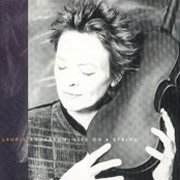 |
Life on a String (2001, 44.12) ***/½ |
|
| One White Whale The Island Where I Come From Pieces and Parts Here With You Slip Away My Compensation Dark Angel Broken |
Washington Street Statue of Liberty One Beautiful Evening Life on a String |
|
Current availability:
Mellotron used:
Laurie Anderson entered the public consciousness, of course, with 1981's very strange O Superman, one of the oddest songs ever to've almost hit the top spot on the UK charts. Her status as performance artist par excellence was sealed many years ago, her innovations including a violin fitted with a tape head instead of strings and a bow strung with a length of tape, making 2001's Life on a String sound fairly normal in comparison. It could be described as avant-garde jazz classical, for want of a better phrase, although none of those sobriquets really fit tracks like My Compensation or Dark Angel.
Mitchell Froom plays Mellotron on three tracks, with near-inaudible flutes on Pieces And Parts and completely inaudible somethings on Broken and One Beautiful Evening, making you wonder why anyone bothered, really. So; a reasonable Laurie Anderson album, but a fairly useless Mellotron one.
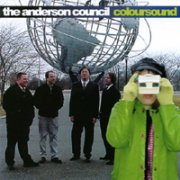 |
Coloursound (2001, 40.50) ***½/T |
|
| Sitting on a Cloud Blackboard of Your Mind Mind Meld Mud Feet of the Guru Hole in the Sky So in Love With You Girl Poppies Pansies and Tea Red Chalk Hill |
Never Stop Being '67 The Coke Jingle |
|
Current availability:
Mellotron used:
The first time I saw Anderson Council's name I laughed out loud; for those at the back, The Pink Floyd (as they were originally known) named themselves after the forenames of two otherwise utterly obscure bluesmen, Pink Anderson and Floyd Council. For the three of you who didn't know the story...
Coloursound (note British spelling, probably from the FX pedal manufacturer) is an utter magpie of an album, copping ideas right, left and centre (note British spelling) from the original UK psych scene, with a few later powerpop tricks thrown in for good measure. The trouble is, as other online reviewers have pointed out, it's so slavishly copyist that the band forgot to put anything of themselves in it. Leslie'd vocal? Check. References to tea drinking? Check. Fake British accents? Check. It's a good album, but it's never going to be in any danger of being a great one. The two fake period-piece Coke commercials are amusing, but for how many times?
Beautifully full-on, very real-sounding Mellotron flutes on Mind Meld Mud, from Peter Horvath, although that's it on the Mellotron front. I suppose the Floyd didn't use one on Piper..., so getting one on here at all is a bit heretical. Anyway, definitely a fun listen, but you probably won't be digging this one out every week. File behind The Dukes of Stratosphear. Definitely behind.
See: Pink Floyd
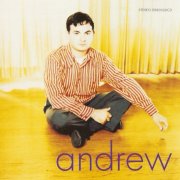 |
Million Dollar Movie (1997, 14.46) ***½/TThe Man Who Would Be KingDream About You Here, Hear What Do You See in Me? Nobody's Someone |
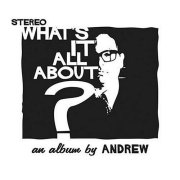 |
What's it All About? (2004, 36.24) ***½/TTT |
|
| We'll Dream Or, Maybe Not I Can't Be Lonely Where I Want to Be How Do You Go on Nevermore Round Going Round How it Goes |
Another Way of Life How Come it Takes So Long The Golden State |
|
Current availability:
Mellotrons/Chamberlins used:
Andrew Sandoval is known more as a producer (particularly of '60s reissues) and author than for his musical activities, although he released four albums and two EPs over the course of a decade or so. 1997's Million Dollar Movie EP sits in prime powerpop territory, highlights including opener The Man Who Would Be King and What Do You See In Me? Sandoval plays Mellotron and Chamberlin on his version of The Bee Gees' Nobody's Someone, which strikes me as a tad gratuitous, given that the track also features real strings. Ticking the boxes? Anyway, I presume he plays machines belonging to co-producer Brian Kehew, with a Chamby strings melody half-way through the track and chordal Mellotron strings towards the end.
Seven years on, Sandoval's style hasn't changed a jot on What's it All About?, highlights including the gentle Or, Maybe Not, Nevermore and How Come It Takes So Long, although there isn't one obvious duffer to be heard. Sandoval on Chamby and Mellotron again, with competing upfront melodies on Or, Maybe Not (one from each machine?), sounding like Mellotron flute and Chamby woodwind-something, stabby Chamby brass and strings and Mellotron flutes and vibes on How Do You Go On, Chamby brass and Mellotron strings on Nevermore and Chamby (?) saxes and Mellotron strings on Round Going Round, gaining the album a full three Ts for some seriously full-on use.
I haven't heard any of Sandoval's other work, but my guess is that's it's not only similar, but also as high quality as these two releases. Sadly, I've seen no evidence of any more tape-replay use; should you know otherwise, please let me know.
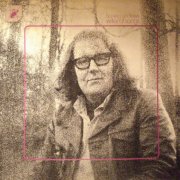 |
Writer of Songs (1972, 43.12) ***/T½ |
|
| Hey! Sandy In the Darkness Boothferry Bridge Unaccompanied Gift of a Brand New Day Soldier Anna (My Love) Born on the Breeze |
Martha When I am Old One Day Soap Opera Writer of Songs |
|
Current availability:
Mellotron used:
Harvey Andrews is a Birmingham-born singer-songwriter, of the kind all-too often lazily and inaccurately described as 'folk'. His second album, 1972's Writer of Songs, features guest spots from a host of 'names', not least Danny Thompson (Pentangle), Daves Pegg and Mattacks (Fairport Convention), Ralph McTell, Cozy Powell and Rick Wakeman (on piano). It does exactly what it says on the tin, highlights including Hey! Sandy (written for a victim of the recent Kent State U. shootings), the excellent Unaccompanied (which also does what it says on the tin) and the harrowing Soldier (apparently the subject of a ludicrous unofficial BBC ban), although fans of the style will have little to complain about with anything here. Criticism? Although I've heard far worse offenders, the album suffers a little from that late '60s/early '70s insistence on 'smoothing over' singer-songwriter material with extraneous arrangement, sometimes affecting the songs' ability to breathe.
Ted Taylor (he of 'awful sixteen-voice Mellotron violins recording' fame) plays Mellotron on a couple of tracks, with lush MkII strings on Boothferry Bridge and more of the same plus a flute solo on Born On The Breeze. To be honest, you're probably not going to bother with this for its Mellotron use, but it's a good example of a folky singer-songwriter album of its day.
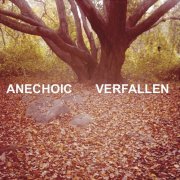 |
Verfallen (2011, 52.55) ***½/TT |
|
| Logistic The Keep Baritøne Stepsøne Cluster Heeyoum Alpha Centauri Stone Yuggothian Landscape Baritøne Stepsøne (reprise) |
Ulnaris Verfallen |
|
Current availability:
Mellotron used:
Anechoic are led by Peter Scartabello, also of Sky Shadow Obelisk, although that outfit's full-on doom is replaced on 2011's Verfallen by an intriguing mixture of progressive, darkwave, psych and (the slightly inevitable) doom, to name but four of the genres it mines. The album (their third) shifts between the psychedelia of The Keep, the suitably avant-proto-prog of Cluster, the experimentation of Heeyoum and the progressive hard rock of Alpha Centauri Stone, although its most impressive track is possibly the solo Mellotron frenzy of Yuggothian Landscape.
David McNally plays an upfront Mellotron flute part on The Keep, while Yuggothian Landscape has cellos grinding away on the intro, joined by strings and flutes later on, all sounding wobbly enough to be genuine. Those of you who were put off by Sky Shadow Obelisk's heavily metallic overtones may find Anechoic more to your liking, although the album's stylistic variety conspires to make it a little uneven.
Official Peter Scartabello site
See: Sky Shadow Obelisk
Anekdoten (Sweden) see: |
 |
Ange (France) see: |
 |
Angel (US) see: |
 |
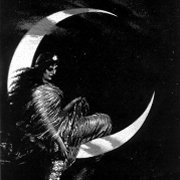 |
Stars Below (2000, 42.40) ****/TTT |
|
| Ether Silver Garden Stars Below Angelhaze Angelwaves Light Chant Glassy Halls |
Je Suis Partie Pour ne Pas Revenir Siren Angel's End |
|
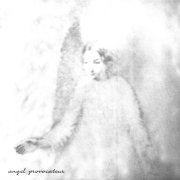 |
Cloud Street (2003, 38.59) ***½/TT½ |
|
| Miracle Alley In the Tall Grass Pipes of Pan Stalactites Rapunzel Her Window Somewhere Faraway Castle Walls |
Strumming Magnetic Shadow Chant Magnetic Curtain She Was Here |
|
Current availability:
Mellotrons used:
Angel Provocateur are part of the Ventricle Records interlinked group of darkwave outfits, along with the better-known (relatively speaking) Mauve Sideshow, concentrating on 'ethereal female vocals', not to mention a goodly helping of the mighty Mellotron. Their second release, Stars Below, is most certainly ethereal, with no discernable rhythms, the only credited instruments being 'voice, Mellotron and electronics'. Dusty Lee's Mellotron takes a while to come in, but after the title track's faint cellos, Angelhaze consists almost entirely of voice and Mellotron strings, heavily reverbed, setting the pattern for the rest of the album's use, although there's also a short burst of flutes on Je Suis Partie Pour Ne Pas Revenir. I have to say this is, while largely formless, quite beautiful in places; I expect it's meant to be listened to by candlelight and that sounds like the best listening environment for this drifting, almost elegiac music.
Three years on, its follow-up, Cloud Street, is effectively more of the same; I found it just marginally less engaging, although I've no idea why. Maybe because I'm beginning to feel I've heard it all before? There's little obvious difference between these two albums and you feel Ventricle could go on churning these out until the sun goes cold, although I suppose that's a little uncharitable. Anyway, although there's a touche of background Mellotron strings (from Lee again, of course) on In The Tall Grass, the first major use occurs in Rapunzel, with full-on strings and flutes, right at the front of the mix, with more strings on Her Window. However, the album's real Mellotron track is also its longest, the eight minutes-plus Castle Walls, with stacks of strings and flutes; very nice.
See: Kangaroo Kourt | Mauve Sideshow | Steeple of Fyre | Torn Curtain
Änglagård (Sweden) see: |
 |
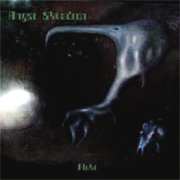 |
Flukt (2008, 34.24) ***½/TU.F.O. (Intro)Silent Light, Alien Night A Song to the Sky Negativitetens Kveletak The Astroid Haemorhoids and the Drunken Sailor Slaves of Mental Distortion Beyond Andromeda Satan (outro) |
Current availability:
Mellotron used:
Angst Skvadron are comprised of members of various other Norwegian bands playing under initials, chiefly T.B., a.k.a. Thondr Nefas (so not T.N.?) on vocals, guitar and bass and L.F.F., a.k.a. Lars Fredrik Frøislie, known to us for his sterling analogue work with Wobbler, White Willow and a host of other Norwegian outfits. Frøislie actually plays drums here, unexpectedly, also playing the more typical MiniMoog, ARP Axxe, Clavinet, Korg Polysix and, of course, M400. I've seen Flukt described as 'melodic black metal', which strikes the non-believer as a bit silly; it's a relatively melodic metal album, never mind the sub-sub-sub-genre, with rather growly vocals that stop short of the full death-grunt.
Frøislie's keyboard work crops up here and there, though it's far from ubiquitous, with sequenced ARP on U.F.O. (Intro), modulated Mini on A Song To The Sky and Polysix parts on a couple of tracks, but what's with the Close Encounters theme that opens the stupendously-titled The Astroid Haemorhoids And The Drunken Sailor? He only obviously uses his Mellotron once, with cellos and strings in the quiet end section in The Astroid Haemorhoids (etc.), although it's possible it's elsewhere, using an unusual sound, buried away in the mix.
So; modern metal that doesn't actually aurally crush the listener to an untimely death. Having just been subjected to a weekend of such things, I can say that this is a joy to listen to in comparison (I mean, have you ever HEARD Machine Head?), although it's unlikely to appeal to the average old-school hard rock fan. Only slightly over a minute of Mellotron on the whole record, too, but it's a good minute.
See: Wobbler | White Willow
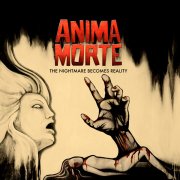 |
The Nightmare Becomes Reality (2011, 47.21) ****/TTTT |
|
| Voices From Beyond Corridor of Blood The Revenant Contamination Passage of Darkness Solemn Graves Delirious Feast of Feralia |
The Nightmare Becomes Reality Things to Come The Dead Will Walk the Earth |
|
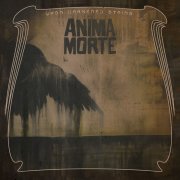 |
Upon Darkened Stains (2014, 60.54) ****/TTT½ |
|
| Blessing of the Dead Illusion is the Catalyst Ephemeris Fear Will Pass Over Your Mind Wakeless Interruption The Darkest Pattern The Carrion Crow |
Echoing the Red Isomorphia First Snow on the Last Ashes Halls of Death |
|
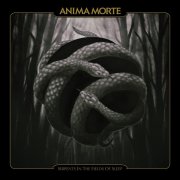 |
Serpents in the Fields of Sleep (2022, 41.37) ****/T½Leaving Redemption BehindPathogenesis Seeds of Trepidation A Perfect Void Blood of the Iconoclast Colors of Incrimination Serpents in the Fields of Sleep The Underworld Beckons Night of the Final Act |
Current availability:
Mellotron(s) used:
Anima Morte (which I suspect is the Latin for 'zombie') are led by multi-instrumentalist Fredrik Klingwall (Rising Shadows), whose raison d'être seems to be to recreate Goblin's horror flick soundtrack/prog approach, updating it with heavier guitars and modern production techniques. After a sample-using debut, 2011's The Nightmare Becomes Reality is a triumph of doomy key changes and analogue keyboards, although I'm not fully convinced by the cod-Dario Argento sleeve imagery. Best tracks? This is a 'listen to in one go'-type album; attempting to pick out highlights is futile, as is resistance. A cursory glance at the album's credits will inform you that none other than Mattias Olsson (Änglagård, a million others) plays on the album, albeit in his traditional 'percussives' role, although it's obviously his Mellotron(s) we're hearing. Klingwall plays male voice choir on all but one track, adding strings to Contamination, Feast Of Feralia and Things To Come and flutes to Solemn Graves and Delirious, the title track being the lone (seemingly) Mellotron-free effort. So why only four Ts? Most of the choir work is a tad unimaginative, merely block chords layered over whatever else is going on, but when there's this much Mellotron to be heard, who's complaining?
Album no. 3, 2014's Upon Darkened Stains, follows on more obviously from its predecessor than their debut (unsurprisingly), although the extra fifteen minutes' length (longer tracks, not more of them) doesn't really do it many favours. Because? Although only two of its twelve tracks top the six- (in fact, the seven-) minute barrier, much of the material outstays its welcome by a minute or more. Not that it's any of my business, but some editing might have improved the end result. Top tracks? Piano-led opener Blessing Of The Dead, Interruption and The Darkest Pattern, perhaps, making me think I might prefer their less full-on material. Mellotron across the board, although my mild complaint from Nightmare... crops up again: too much block-chordal male choir, thus the lower-than-it-might-have-been rating.
After several years off, Klingwall restarted his project with a series of scores for readings of H.P. Lovecraft stories, at least one of which features the Mellotron. His next Anima Morte release proper was 2022's Serpents in the Fields of Sleep, sticking to his standard heavy horror-flick-soundtrack template; once again, an ensemble piece, although opener Leaving Redemption Behind features some Spaghetti Western-style guitar work. In a mix this dense, it's often difficult to tell what's what, but it only really sounds like Mellotron on the first three tracks, with choirs on Leaving Redemption Behind, choirs and church organ on Pathogenesis (alongside regular choir samples) and more organ on Seeds Of Trepidation. Have I missed parts? Have I credited it where it isn't? Hard to say, but the album keeps up the quality, although I'm not sure Klingwall's vision isn't starting to sound a little formulaic.
See: Samples etc. | Rising Shadows
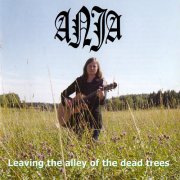 |
Leaving the Alley of the Dead Trees (2007, 46.36) ***/TTT |
|
| Galloping Your Beach Changing Your Beach Oh I Wish A Sad Pose Leaving the Alley of the Dead Trees At Your Feet My Dark Star Presence |
Breakdown A Flying Dream Song to the Spared I Want to Stay |
|
Current availability:
Mellotron used:
Anja (Kvernplassen?) is a Swedish singer-songwriter, active since the late '90s, although, to date, she's released just the one solo album, 2007's Leaving the Alley of the Dead Trees. Her work lies at the darker end of the spectrum, album highlights including proggy opener Galloping Your Beach, A Sad Pose, Song To The Spared and closer I Want To Stay. The album was recorded at Pär Lindh's Crimsonic studio, Lindh and American progressive bassist William Kopecky amongst the musicians; several tracks feature no more than Anja's voice and acoustic guitar, although Lindh accompanies her on piano on two songs: slightly overly-ornately on Breakdown and rather inappropriately jauntily on A Flying Dream, other tracks including Kopecky's bass, occasional drums and Lindh on other keys.
Lindh plays Mellotron, with background strings on Galloping Your Beach, less of the same on Changing Your Beach, two flute solos on Oh I Wish, distant choirs and strings and another flute solo on A Sad Pose and upfront, chordal strings on Presence and closer I Want To Stay. An album of two halves, then, only one featuring the Mellotron.
See: Pär Lindh
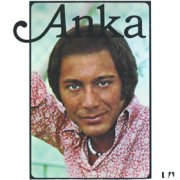 |
Anka (1974, 32.35) **/TTT |
|
| Bring the Wine One Man Woman/One Woman Man Something About You (You're) Having My Baby Let Me Get to Know You Love is a Lonely Song How Can Anything Be Beautiful (After You) I Gave a Little and Lost a Lot |
Papa It Doesn't Matter Anymore |
|
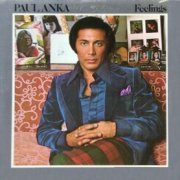 |
Feelings (1975, 33.49) **/T |
|
| Anytime (I'll Be There) I Don't Like to Sleep Alone Out of My Mind in Love It's So Sad to See the Old Hometown Again (I Believe) There's Nothing Stronger Than Our Love Wake Up Today, I Became a Fool Girl, You Turn Me on |
Walk Away Water Runs Deep |
|
Current availability:
Mellotrons used:
Paul Anka remains best-known for his early work, including Diana, Oh Carol and the English lyrics to My Way (he didn't actually write the song, contrary to popular opinion), although he remains musically active to the present day. In the mid-'70s, he was making soft pop albums, very much in contemporary style and still having hits, not least his doubtless unintentionally creepy US no. 1, (You're) Having My Baby. Its parent album, '74's Anka, is actually a perfectly good album of its type, assuming you like its type, balancing on a knife-edge between mainstream pop and loungey MOR, including another major hit, his paean to 'playing away', One Man Woman/One Woman Man. What was that I was saying about creepy lyrics? Anyway, most unexpectedly, the album's stuffed with Mellotron, presumably played by either John Harris or Anka himself. The funny thing is, a few tracks have real strings, so it wasn't as if they didn't have the budget; maybe they actually, y'know, liked the sound? Anyway, we get flutes and strings on opener Bring The Wine and I Gave A Little And Lost A Lot, strings on Something About You, including a brief solo, a flute part on (You're) Having My Baby and more strings on Love Is A Lonely Song and Papa, making for a remarkably Mellotron-heavy album in the field.
The following year's Feelings takes a backwards step, being even more traditionally balladic than its predecessor, most tracks smothered in real strings. There's nothing here as creepy as the hits from Anka, but then, nothing catches the ear like them, either, making for a bland, faceless album from someone who should've been able to do better. The album's worst crime isn't leaving you feeling vaguely soiled, just vaguely bored, exacerbated by a severe lack of Anka's Mellotron use, with nowt but a melodic flute part on closer Water Runs Deep, probably played by Barry Beckett.
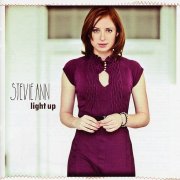 |
Light Up (2010, 40.59) **½/½ |
|
| Light Up Carry Me Home To Forget Her Something Dark What Goes on You Done Me Wrong Waiting & Dreaming Leavin' Town |
That Thing Move on Leaves Keep Falling Down On My Mind |
|
Current availability:
Chamberlin (?) used:
Anna Stéphanie "Stevie Ann" Struijk's third album, 2010's Light Up, is a rather undemanding singer-songwriter pop record, totaly indistinguishable from a million similar US artists. Any better tracks? What Goes On and Leavin' Town, perhaps, while closer On My Mind, while unexciting, is at least heartfelt.
Stevie (it feels wrong referring to her as 'Ann') and producer Mitchell Froom are both credited with keyboards, but, given past performance, it seems likely that Froom plays what sound like faint Chamberlin cellos on What Goes On, particularly given that this was recorded at (his?) West Coast studio. Incidentally, Stevie has now reverted to her real name, on the offchance she'll ever turn up on this site again.
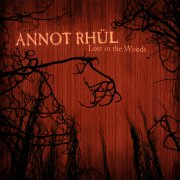 |
Lost in the Woods (2007, 23.06) ***½/TTLost in the WoodsGhost Children Deadly Nightshade Roses Blue Sailing on the River Styx The Dark Lord |
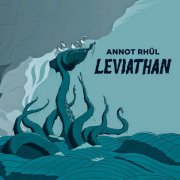 |
Leviathan (2014, 48.32) ****/TTTT |
|
| Leviathan Suite i) The Traveller, part I ii) The Sailors, part I iii) In Limbo at 5000 Fathoms iv) Maybe They Sailed Out Too Far? v) Between Scylla and Charybdis vi) The Sailors, part II vii) Interstellar Foe The Colour Out of Space Surya |
Distant Star The Mountains of Madness R'Lyeh i) The Elder Ones ii) 47°9 S 126°43 W iii) Every Man for Himself iv) In the Wake of Cthulhu v) The Traveller, part II |
|
Current availability:
Mellotrons used:
Annot Rhül are, essentially, Sigurd Lühr Tonna's solo project. His/their first release, 2006's Who Needs Planes or Time Machines, When There's Music & Daydreams? (reviewed here) uses Mellotron samples, but the following year's Lost in the Woods, while far less eclectic than its predecessor (more dark psychedelia, I suppose), is, for this reviewer at least, a more satisfying listen. While several tracks are almost darkwave-influenced, closer The Dark Lord suddenly goes all sort of Scandinavian prog/metal on us, moving away from the ever-present Saucerful of Secrets/Ummagumma Floyd vibe of the rest of the EP. Real and sampled Mellotron this time round (thanks to Sigurd for the info), played by him, with a brief flute part and choirs in the opening title track, cellos on the outro to Ghost Children and strings and choir on The Dark Lord. All other Mellotron parts (and it's pretty much all over every track, especially Deadly Nightshade) are from the M-Tron, for technical reasons. So, Mellotron, anyone? That's more like it.
Seven years on, Tonna finally produces a new Annot Rhül album, 2014's heavily Lovecraft-inspired Leviathan. Highlights include the stately The Mountains Of Madness and the epic R'Lyeh, while psych fans may prefer The Colour Out Of Space, but with no obvious filler, this is a distinct improvement on its distant predecessor. I believe not only Tonna, but Lars Støre Gullichsen (a.k.a. Organ Morgan) from Seid and the ubiquitous Lars Fredrik Frøislie all play (Frøislie's?) Mellotron, with considerable string use on Leviathan Suite and The Colour Out Of Space, flutes and choirs on Surya, vibes on Distant Star, strings all over The Mountains Of Madness, along with what sound like Mellotron tubular bells and brass on R'Lyeh, amongst other use. I'd be lying if I said that the Floyd aren't an ever-present influence, but the sheer quality of the music on offer here transcends minor quibbles such as who influenced whom.
See: Samples etc.
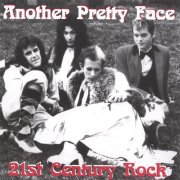 |
21st Century Rock (2004, recorded 1973, 51.12) ***½/T½ |
|
| Planet Earth 18 Scram Wild Child 21st Century Rock Da Doo Ron Ron Little Boys Girl Crazy Stuck On You |
The Great American Candy Bar Debate He'll Fall Bang a Gong Little Boys (alternate take) The Great American Candy Bar Debate (take 3) |
|
Current availability:
Mellotron used:
Led by vocalist Terry Roth, also featuring future Bon Jovi drummer Tico Torres, Another Pretty Face were an early '70s Philadelphia-based glam outfit. They recorded an album with producer Ed Stasium in 1973, subsequently shelved by RCA, perhaps because, as has been pointed out elsewhere, glam never really took off in the States; even the New York Dolls, while deeply influential, were a commercial dud. Roth's overtly camp lyrics probably didn't help their cause in those early days of what was then known as gay lib, either. Anyway, 21st Century Rock finally gained a release thirty years later, revealing that they had little in common with either the Dolls or mainstream Brit-glam, sounding more like the bastard child of Styx and the Spiders, not that Chicago's finest were a household name at that point. It kicks off with magnificent, seven-minute glam/pomp epic Planet Earth, other highlights including Stuck On You and The Great American Candy Bar Debate. Roth camps it up in fine glam style here and there, not least on Little Boys, Girl Crazy and the none-more-gay Stuck On You.
I presume it's keys man Larry D'Amelio on occasional Mellotron, with strings and flutes all over opener Planet Earth and strings on the title track, although the strings on Little Boys and The Great American Candy Bar Debate are string synth. You know how many 'lost classics' turn out to have been lost for a good reason? This isn't one of them. It's not all great, but its heights soar above many, many commercially-released albums. Worth a listen. Incidentally, some years later, the band put out a new wave-influenced record in 1980, Face Facts, as T. Roth & Another Pretty Face, quite certainly a) not worth hearing and b) Mellotron-free.
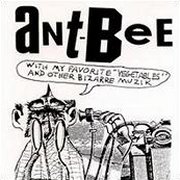 |
With My Favorite "Vegetables" & Other Bizarre Muzik (1993/94, 54.03) ***½/T½ |
|
| Lunar Egg-Clips Runs Amuck The Girl With the Stars in Her Hair Motorhead Snorks - Motorhead Speaks The Live Jam Once the Clothes are Off Stringbeans, Greenbeans + Other Assorted Vegetables Moonpie - Cooked Jimmy Carl Black Speakin' at Ya In a Star Do You Like Worms? |
Bunk Speaks Another Gardner Variation Pachuco Falsetto Laughs Here We Go Round the Lemon Tree Who Slew the Beast? Dom Dewild Speaks Dom Dewild Tranzforms (Before Your Very Ears) Dom Dewild Speaks Again |
|
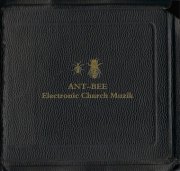 |
Electronic Church Muzik (2011, 64.05) ****/TT |
||
| Birth Living The Language of the Body Eye of Agamoto The Guff (Hall of Souls) Mallard Flies Towards Heaven Ant-Bee's Sunday Supper Flutter-Bye, Butter-Flye |
Endless Journey The Light Mannah Psalm 23 Hallelujah The Wrath - Part One Secrets of the Dead Pennies From Heaven |
The Wrath - Part Two The Lord's Prayer Angels Don't You Ever Learn Re-Birth Final Benediction |
|
Current availability:
Mellotrons used:
Berklee graduate Billy "The Ant-Bee" James is a psychedelic explorer whose career kicked off in the late '80s, his second album, 1993's cassette release With My Favorite "Mothers" & Other Bizarre Muzik being reissued the following year on LP and CD as With My Favorite "Vegetables"... Make no mistake, this is a very strange record, as you might expect, various members of Frank Zappa's original band chatting away between the music, which lurches from full-on weirdness to inspired covers (The Beach Boys' then-unavailable Do You Like Worms?, The Move's Here We Go Round The Lemon Tree). On/off fascinating, but not for the faint-hearted. Some years back, Billy wrote to tell me that his Mellotron originally belonged to '70s pop artist B.J. Thomas' keyboard player, who sold it to Bruce Cameron, from whose estate Billy obtained it after Bruce's death. I thought it was only used on Here We Go Round The Lemon Tree, with a few seconds of strings, but a close listen reveals background choirs on opener Lunar Egg-Clips Runs Amuck, occasional strings and choir on The Girl With The Stars In Her Hair and strings on In A Star.
2011's Electronic Church Muzik is only his fourth release in two decades. James has pulled together a stellar cast, contributors including Daevid Allen and Gilli Smyth (Gong), Michael Bruce (the original Alice Cooper Group), Peter Banks (Yes/Flash), Jan Akkerman (Focus), the late Bruce Cameron and several members of his beloved Mothers of Invention and Captain Beefheart's Magic Band. It's hard to say for sure, but the album seems to have some kind of religious connection, not only in its title, but in the choral parts on several tracks, not to mention the disc's dedication 'to God'. It couldn't be further from your typical CCM horror, though, more an updating of David Axelrod's work on The Electric Prunes' Mass in F Minor.
So what does it sound like? True psychedelia, is the answer, in that every track sounds different to every other, sound effects are practically obligatory and nothing here could even remotely be described as 'normal'. Individual examples include Eye Of Agamoto, which sounds like Gentle Giant channelling Zappa, Sunday Supper credits 'Michael Bruce (vocal), Chickens (chickens)' and he ain't kiddin', Mannah is effectively a jaw-dropping Akkerman solo acoustic guitar piece, while Psalm 23 and Hallelujah form a two-for-the-price-of-one psychedelic church experience. So what does James himself do? Apart from composing, it seems he's overall co-ordinator, playing percussion on most tracks, plus tape manipulation, the occasional guitar part and... Mellotron. Billy plays his M400 on four tracks, with flutes and cellos all over the gentle Flutter-Bye, Butter-Flye, flutes on Mannah and The Wrath - Part One and strings on Don't You Ever Learn. All in all, Electronic Church Muzik is a roller-coaster ride of an album, endlessly inventive, deeply eccentric and more than worthy of your attention.
See: Gong